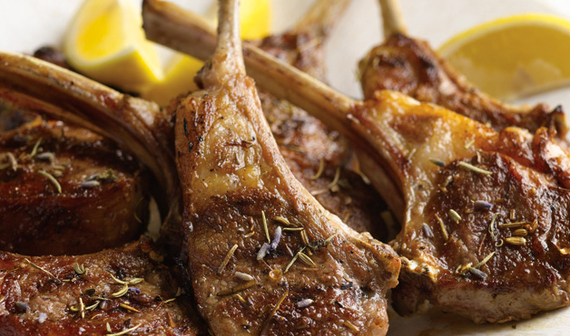Despite its popularity elsewhere in the world, lamb consumption in the U.S. has dwindled to less than one pound per person per year -- about half of what it was in the 1990s when I started writing The Barbecue! Bible series. (In contrast, Icelanders eat an impressive 55 pounds per year.) Clearly, many Americans don't eat lamb much. Some have never even tried it.
If you're adding more lamb into your diet, find out what to look for when buying.
Leg or chop? Lamb is not inexpensive -- especially lean cuts like rack of lamb and lamb chops. (Remember Economics 101? When demand for a commodity is relatively low, supplies drop, which drives prices up and perversely drives demand even lower.) You get the best bang for the buck from leg of lamb and the shoulder.
Domestic or imported: Many supermarkets and big box stores sell grass-fed lamb imported from New Zealand or Australia. (Whole Foods reports some of its stores import Icelandic lamb, but only in the fall.) It is generally smaller, leaner and less expensive than domestically raised lamb. While American lamb can be harder to find -- unless you live in Colorado, which leads the country in lamb production -- it is often available at butcher shops and farmers' markets as well as online. Get a comprehensive list of where to buy American lamb.
Grass-fed or grain-fed: Generally speaking, sheep from New Zealand and Australia are grass-fed and are bred primarily for wool. American lamb, mostly bred for meat on family farms and ranches, can also be grass-fed, but like beef, it might be finished on grain to increase marbling and tenderness.
Grade: The USDA grades lamb prime the same way it grades beef. At the retail level, prime (best quality) and choice (very good) are the consumer's options.
If buying leg of lamb, you'll have just one more decision to make, and that's bone-in or boneless.
I personally prefer bone-in leg of lamb. The bone helps the meat hold its shape, boosts flavor, looks cool, and can be gnawed on later when no one's looking. (Do, however, ask the butcher to remove the aitchbone, which juts from the hip bone and is part of the pelvis. It's pronounced "eytch-bone," and your butcher will be impressed that you know about it.) For a professional-looking presentation, tie the roast at intervals with butcher's string before affixing the meat to the spit.
On the other hand, boneless leg of lamb cooks faster and more evenly, and is more convenient to carve. But trimming and deboning a leg of lamb is not for amateurs. Ask your butcher to do it. Ask him or her to roll it and tie it, too -- just don't do it 20 minutes before the store is about to close for the evening. In fact, order it in advance to maintain good relations with your meat purveyor.
SIGN UP for Steven Raichlen's UP IN SMOKE newsletter to learn more about barbecue!
Steven Raichlen is the author of the Barbecue! Bible cookbook series and the host of Primal Grill on PBS. His web site is www.barbecuebible.com.
